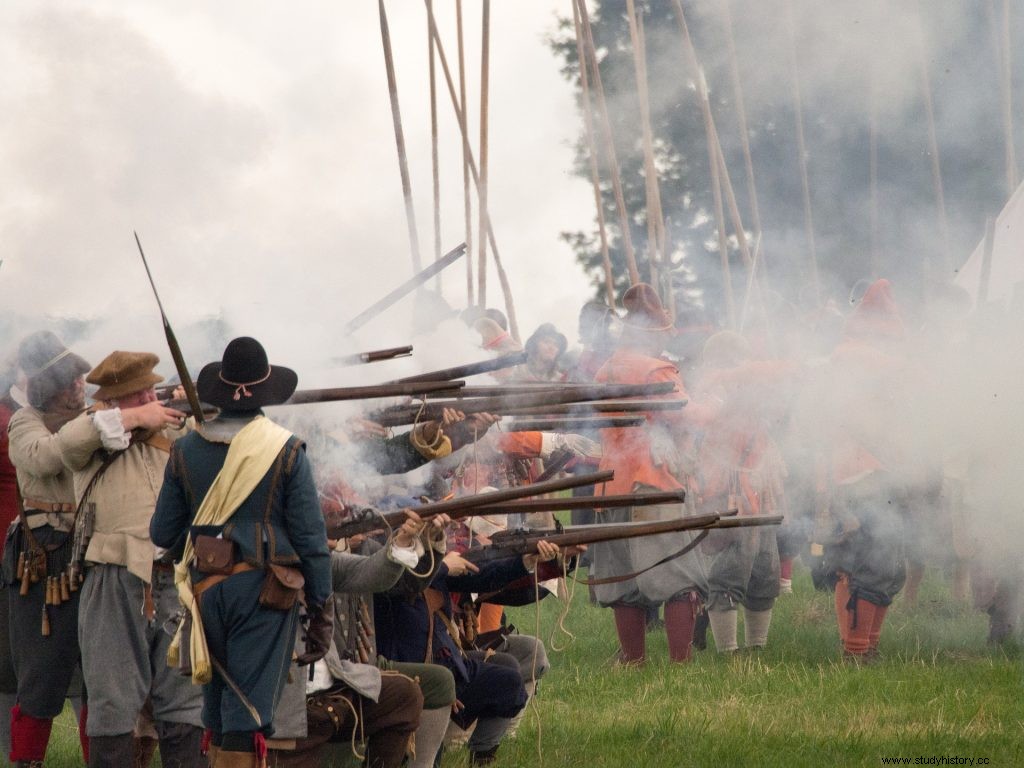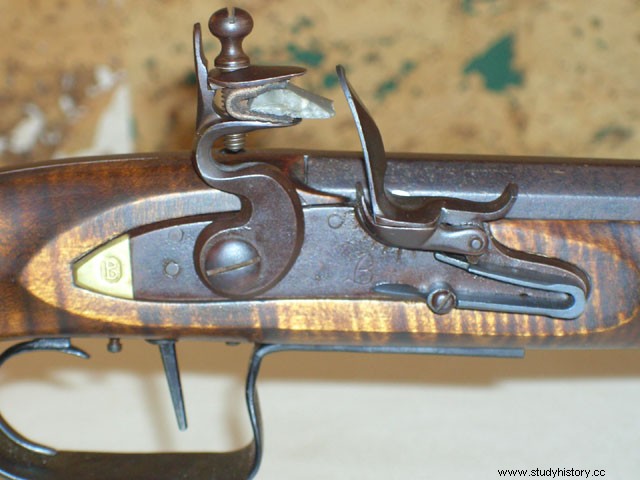At the beginning of the 15th century, warfare changed worldwide with the development of the first matchlock rifles. Like the true-to-original rifle replicas of the later flintlock and percussion lock rifles, this milestone in weapon technology is indispensable for re-enactors today when re-enacting historical battles. For those who aren't quite that deep into the topic yet, we've taken a closer look at the historical ignition devices.
The matchlock - the first mechanical ignition device
The matchlock gun appeared in Europe in the Middle Ages, around the mid-15th century. Classic European matchlock rifles held a slow-burning match in a clamp at the end of a small curved lever called a serpentine or snake. Pulling this lever lowered the glowing fuse into the powder pan. The smoldering fuse ignited the gunpowder on the pan and finally the main charge in the gun barrel via the ignition hole.
The advantage of the matchlock was the easier handling when firing. The smoldering fuses of the first rifles still had to be manually pressed into the powder pan. This left the shooter with only one free hand to hold the rifle in position. If he wanted to aim reasonably well, he needed a second man to hold the match. The matchlock mechanism made this process much easier for the shooter.
However, the matchlock rifle has a few serious disadvantages. The shooter often had to correct the fuse so that it burned continuously. In addition, the fuse and the powder in the pan were sensitive to moisture. The powder could fall out of the pan or be blown out by a gust of wind. In addition, the glowing fuse often gave away the position of the shooters during night operations.

Matchlock rifles were used in Europe, North America and Asia until the early 18th century. In the Nordic Wars from 1554 to 1721, rifles played an important role, for example in 1564 in the Battle of the Ulla and in the Battle of Orsch and in the siege of Pskov in 1581/82. In addition, matchlock rifles were a common weapon for many mercenaries in the Thirty Years' War from 1618 to 1648 and in the English Civil War from 1642 to 1649.
The flintlock rifle - reliable and easy to use
The first flintlock rifles were developed in the early 17th century and gradually replaced the unreliable matchlock rifles. French armourer Marin le Bourgeoys introduced his invention to King Louis XIII of France shortly after his accession to the throne in 1610. The new flintlock system quickly became popular and was known in various forms throughout Europe by 1630.
With a flintlock rifle, the shooter cocks a spring mechanism before firing. If he pulls the trigger, the hammer hits the firmly clamped flint on a metal flap known as a battery, which closes the powder pan. This blow opens the pan and the sparks knocked off the battery by the flint ignite the primer in the pan. The jet of flame generated in this way ignites the propellant charge in the gun barrel through the ignition hole. Due to the covered pan and the flint, flintlock rifles were much less sensitive to moisture than matchlock rifles.

The Nothardt M/1801 rifle is a typical flintlock musket and a popular replica rifle. Among other things, it was used in 1806 in the Battle of Jena and Auerstedt. The M/1801 featured several improvements over its predecessor, the Prussian Infantry Rifle Model 1780/87. It was about a kilogram lighter, had a smaller caliber and a shorter barrel. Good gun replicas of this model share the same characteristics. A sight was used for the first time in the Nothardt rifle. Previously, it was common practice to aim roughly at the target over the barrel. Flintlock rifles such as the Potsdam Muskete 1740, which is also available as a replica rifle, were used in the Napoleonic Wars and the American Civil War, among other things, up to the end of the 19th century.
The percussion lock rifle - forerunner of modern rifles
Let's recap:To date, shooters used stone and steel to create a spark to ignite the primer. A lot of smoke develops and a flash at the moment the spark strikes. These were major disadvantages, especially when hunting, since the hunters involuntarily warned the game. The Scottish pastor Alexander Forsyth did not want to accept this any longer and developed the weapon ignition using a percussion cap filled with an impact-sensitive ignition charge. As a result, when the trigger is pulled, the pre-tensioned hammer hits the ignition charge, which then ignites the propellant charge.
The gun replicas of the British Army Baker Rifle of 1806 with percussion lock or the gun replicas of the Austrian Lorenz Musket of 1854 are often used in battle scenes. Among other things, the originals were used in the Prussian-Danish War from 1848 to 1851, in the American Civil War from 1861 to 1865 and in the Italian Wars of Independence from 1860 to 1870. From the middle of the 19th century, the percussion lock gun was gradually replaced by the percussion gun.
Header image:"Musketeer 1620" by Jurgan Said, published in Photo Battle Calendar 2019 (September)
